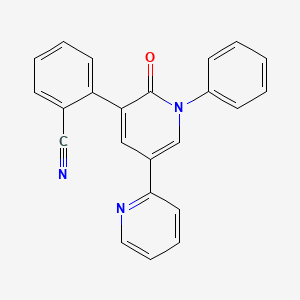Attribution Statement: LactMed is a registered trademark of the U.S. Department of Health and Human Services.
NCBI Bookshelf. A service of the National Library of Medicine, National Institutes of Health.
Drugs and Lactation Database (LactMed®) [Internet]. Bethesda (MD): National Institute of Child Health and Human Development; 2006-.
CASRN: 380917-97-5

Drug Levels and Effects
Summary of Use during Lactation
A minimal amount of information indicates that perampanel milk levels are quite low. If perampanel is required by the mother, it is not a reason to discontinue breastfeeding, but monitor the infant for drowsiness, agitation, adequate weight gain, and developmental milestones, especially in younger, exclusively breastfed infants and when using combinations of drugs.
Drug Levels
In published reports of anticonvulsant use during breastfeeding, most women were taking a combination of anticonvulsants. Some other anticonvulsants (e.g., phenytoin, carbamazepine) stimulate the metabolism of other drugs including anticonvulsants, whereas others (e.g., valproic acid) inhibit the metabolism of other drugs. Therefore, the relationship of the maternal dosage to the concentration in breastmilk can be quite variable, making calculation of the weight-adjusted percentage of maternal dosage less meaningful than for other drugs in this database.
Maternal Levels. A mother was taking perampanel 8 mg daily as well as lacosamide 200 mg twice daily and brivaracetam 100 mg twice daily. Her milk perampanel levels were 0.31 micromoles/L (108 mcg/L) on day 5 postpartum 12 hours after the previous dose and 0.15 micromoles/L (52 mcg/L) on week 5 postpartum 13 hours after the previous dose.[1]
Two breastfeeding women who were taking perampanel 4 mg daily plus lamotrigine had perampanel levels measured in their milk. One woman had a milk level of 0.06 mg/L at 3 days postpartum. The other woman had an undetectable (<0.01 mg/L) milk level at 4 days postpartum.[2]
Infant Levels. A mother was taking perampanel 8 mg daily as well as lacosamide 200 mg twice daily and brivaracetam 100 mg twice daily. Her infant was exclusively breastfed and had serum perampanel concentration of 0.23 micromoles/L (80 mcg/L) on day 1, 0.49 micromoles/L (171 mcg/L) on day 5, and 0.23 micromoles/L (80 mg/L) in week 5 postpartum, which are near the lower end of the therapeutic range of 0.25 micromoles/L. At week 11 postpartum, the infant was partially breastfed and perampanel was undetectable (<0.15 micromoles/L; <52 mcg/L) in the infant’s serum.[1]
One breastfeeding mother taking perampanel 4 mg daily plus lamotrigine had perampanel measured in the serum of her and her infant. Her infant had a serum level of 0.16 mg/L at 4 days postpartum, and an infant-to-maternal serum concentration ratio of 0.36 at 4 days postpartum.[2]
Effects in Breastfed Infants
An infant was exclusively breastfed by a mother taking perampanel, brivaracetam and lacosamide for 6 weeks, then partially breastfed. The infant did not exhibit reduced wakefulness or feeding problems. At one year of age, the mother reported normal development.[1]
Effects on Lactation and Breastmilk
Relevant published information was not found as of the revision date.
Alternate Drugs to Consider
(Seizure Disorder) Carbamazepine, Divalproex, Gabapentin, Lamotrigine, Oxcarbazepine, Phenytoin, Valproic Acid
References
- 1.
- Landmark CJ, Rektorli L, Burns ML, et al. Pharmacokinetic data on brivaracetam, lacosamide and perampanel during pregnancy and lactation. Epileptic Disord 2021;23:426-31. [PubMed: 33935028]
- 2.
- Kacirova I, Urinovska R, Grundmann M. Therapeutic monitoring of lacosamide, perampanel, and zonisamide during breastfeeding. Epilepsy Res 2023;199:107264. [PubMed: 38041996]
Substance Identification
Substance Name
Perampanel
CAS Registry Number
380917-97-5
Disclaimer: Information presented in this database is not meant as a substitute for professional judgment. You should consult your healthcare provider for breastfeeding advice related to your particular situation. The U.S. government does not warrant or assume any liability or responsibility for the accuracy or completeness of the information on this Site.
- User and Medical Advice Disclaimer
- Drugs and Lactation Database (LactMed) - Record Format
- LactMed - Database Creation and Peer Review Process
- Fact Sheet. Drugs and Lactation Database (LactMed)
- Drugs and Lactation Database (LactMed) - Glossary
- LactMed Selected References
- Drugs and Lactation Database (LactMed) - About Dietary Supplements
- Breastfeeding Links
- PubChem SubstanceRelated PubChem Substances
- PubMedLinks to PubMed
- Review Brivaracetam.[Drugs and Lactation Database (...]Review Brivaracetam.. Drugs and Lactation Database (LactMed®). 2006
- Review Ezogabine.[Drugs and Lactation Database (...]Review Ezogabine.. Drugs and Lactation Database (LactMed®). 2006
- Review Escitalopram.[Drugs and Lactation Database (...]Review Escitalopram.. Drugs and Lactation Database (LactMed®). 2006
- Review Levetiracetam.[Drugs and Lactation Database (...]Review Levetiracetam.. Drugs and Lactation Database (LactMed®). 2006
- Review Duloxetine.[Drugs and Lactation Database (...]Review Duloxetine.. Drugs and Lactation Database (LactMed®). 2006
- Perampanel - Drugs and Lactation Database (LactMed®)Perampanel - Drugs and Lactation Database (LactMed®)
Your browsing activity is empty.
Activity recording is turned off.
See more...
